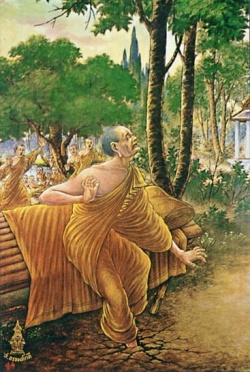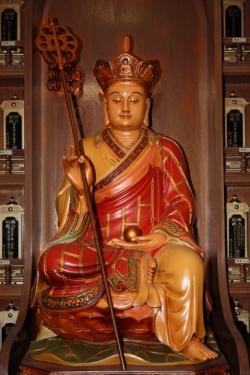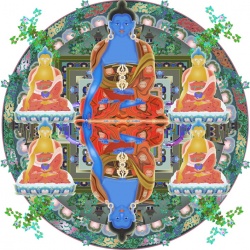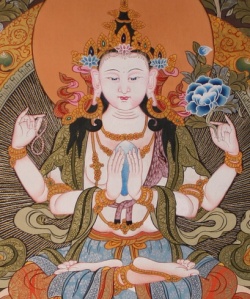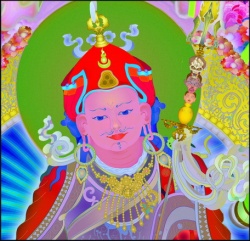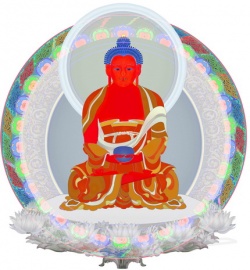The three yanas of the Dorje Kasung and social action
Dear Dorje Kasung,
In its work to achieve Victory Over War and other worth objectives towards building enlightened society the Dorje Kasung plays a leading role in social engagement. I hope you will consider sending representative from the Dorje Kasung to the program to be held later this month on the Shambhala Path of Social Action at Dorje Denma Ling. President Reoch will be leading the upcoming program joined by leading Shambhalians in the field. This program is an important step in developing our sangha's approach in "Opening the Flower Outwards" as encouraged by Sakyong Mipham. We would love to have broad participation in the program and the overall exploration of what social action and engagement might mean for our sangha in the future. I invite you to contact me to discuss ensuring Kasung representation. In the Great Eastern Sun
Lance Brunner Chair Social Engagement Advisory Group to President Reoch
Here are one kasung’s thinkings on that subject in the framework of the three yanas of the Dorje Kasung – a teaching that answers the question “What do we protect?” in terms of each yana. The first is – we protect our own minds. Only with that foundation do we go on to try to protect the connection between the spiritual world and the secular world (second yana of DK), finally moving out to try to protect the phenomenal world itself (third yana of DK). In the current movement to social action, we may be passing through step one, mind protection, too quickly to have the result actually be Shambhala Buddhist social action. If so, the result may be people merely engaging in activities they normally would, guided by their pre-existing political leanings, but now labeling it “Buddhist.”
INSTITUTION AS MIND
Here the mind to be protected may be not only individual, but also institutional. It seems that an organization can be seen as a mind. If so, it has qualities of both wisdom and ego as does individual mind. The mind protection here would be for Shambhala International (SI) to clearly elucidate its view on certain questions, some of which have been discussed at length, but not resolved. This elucidation would either be at the level of a teaching or of an ‘official’ position, depending on the subject. We are undertaking to turn the flower outward. We need to understand a little better what the flower is. We hope the flower will be experienced as fragrant by those to whom we turn it. To the extent that there are areas where it is not fragrant, we need to be painfully honest about what those areas are, and how those scents are to be worked with according to the teachings we will be asking the public to accept as helpful and uplifting to them. People collectively are not dumb. Without this honesty, they may experience the social action project as another religion based do-gooder effort with a fair amount of hypocrisy below a smiley surface.
COEMERGENCE AS A WEAPON OF NON-THEISTIC INSIGHT
To look at our institutional mind with its opposing cross-currents and conflicting values, a powerful lens can be what is probably the most basic Buddhist insight about the nature of mind and, I submit, all of social reality. Everything that arises is a blend of wisdom and ego, bravery and cowardice, clarity and confusion. They arise together. If that is so, then when examining or evaluating any area of human affairs, it is not necessary to ask “Is that wisdom there?” “Is there ego here?” The answer to both questions and their opposites will pretty much always be “Yes.” Yes, there is wisdom; and yes, there is ego – both operating at the same time in all of our institutional actions. Taking that point of view would go a long way toward cutting through intractable polarities. The mere acceptance of that less-than-perfect, or not-totally-evil reality will often be a big revelation in itself. After that, a less crucial, but often useful, step would be to try to sort out which is which. The process could get tricky or not.
A further observation is that a theistic mindset will not accept that the wisdom/ego mix is present in matters it feels the need to defend. It could be said that theism denies that connate quality of reality. In simplest terms, the theistic view might be that most things exhibit coemergence, but God does not. God is straight wisdom, good, holiness, etc. (This implies that there are also all-ego, all-bad entities and situations.)
Then quickly follows the corollary that God’s institutions, God’s bureaucrats, God’s car, etc., are similarly without stain. When bureaucracies, institutions, corporations and people try to see themselves as all good, no bad, that movement of mind is fundamentally the same – theism – as in the literally religious context. Something important to watch for is that the theistic approach will use rationalization, employing profound principles, vision, dharma, scripture to justify all its aspects as wisdom, including those that are actually confused, ego based. But sometimes those vision explanations actually will be genuine. It may really be the wisdom aspect manifesting. How do we tell if claimed virtue is just that or if the claim is a cover for vice? I think that whenever big ideas are deployed to explain or justify something, our non-theism sensors should switch on: what is the actual blend of wisdom and ego that is being presented as pure wisdom? Perhaps that is the essence of kasungship in organizations and social action – a good BS meter.
Applying the insight that all is a mix of wisdom and confusion to our own institutional mind and to social questions would be true to our stated identity as a non-theistic spiritual tradition.
START WITH SOCIAL ACTION WITHIN S.I., THEN BY S.I.
Concerning institutional mind protection, a necessary foundational social action might be that people continue to lobby SI and the Sakyong for clear statements of position and teachings in certain areas that require them before meaningful external engagement can happen with genuineness. We need a lot of hinayana level social action first. The people who refused to let their concerns about the Vajra Regent go unaddressed all these years were engaged in social action within SI. It took courage. Once we have a strong foundation of internal genuineness, SI itself could use its status to engage in social action by taking public positions on issues of the broadest significance specifically relevant to a religious organization with social teachings. The latter could be related to protecting the world, the third yana of the Dorje Kasung. I propose that three areas be addressed by the Sakyong and SI (somewhat loosely related to the three yanas of protection): 1) Issues specific to our lineage and sangha that involve values fundamental to decent society, e.g., the politics of the two Karmapas controversy, and the Vajra Regent’s actions. 2) Questions that are the province of religious, spiritual teaching organizations: those of basic metaphysical understanding and key questions of morality, e.g., when does life begin and when may a person or institution end the life of another?
3) Taking positions on matters of worldwide concern that involve relevant spiritual values, e.g., the use of spiritual teachings to promote murder and hatred on a global scale – Islamist terrorism.
1] Teachings and clear statements of how to regard crucial events in our own community
a) The selection of His Holiness Karmapa
We need a body of teachings about wisdom and neurosis in the conduct of politics. Vajradhatu and SI have always been all about politics. At the1978 Seminary, we had a class called Vajra Politics taught by Karl Springer in which Machiavelli’s The Prince was required reading. Many students seemed to take that as an official suggestion about how to treat people. Coincidentally, this was at the same time and place that some of the core Shambhala texts were received. The message in those days was openly that politics is an integral part of life and the Shambhala world. “The moment a woman becomes pregnant, there is politics.” (Attributed to CTR) Those who expressed distaste with the emphasis were criticized as unsophisticated, naive, not connected to the vision.
The coemergent ego side of politics received little didactic commentary. Although our proclivity for politics is no longer openly acknowledged, it remains at about the same strength. This well may be perfectly proper. But social action is all about politics, too – politics within the action group, the politics of how to affect change, attempts to directly influence the politics of governments. As we are being encouraged to fully enter this arena, the community needs specific teachings on what the politics of enlightened society are. The teaching should give equal or greater time to describing what the ego driven component of politics looks like so we can more readily spot it when we do it. We claim we can improve the world by putting our teachings into action, but we have very few teachings in this area that underlies our proposed social action. The output of a series of talking circles is not the equivalent of a Shambhala teaching. That comes from the teacher.
The politics of the Karmapa tulku selection controversy would be an excellent vehicle for the Sakyong to evaluate for us what happened in terms of wisdom-based and ego-driven politics. Along with politics in general, the tulku system itself is an area in need of candid teachings. It is not far-fetched that a proposed recipient of our engaged Buddhist offering will want information about the tulku system and will have heard about the two Karmapas conflict. At this point, what could our activist say? “We asked our teacher about that and he just said he tries to stay out of Tibetan politics.” “The tulku system is one of the most of the most profound, unique aspects of our spiritual tradition, but in our more inner circles, we don’t take it seriously.
The Sakyong’s tulku step brother publicly opines that his recognition was probably just political.” We need teachings on the wisdom and confusion manifested in all that. In our mission statement about social engagement we say we will create an enlightened society that spans the world. If an engagee were to ask what our teachings are on the enlightened politics of that world as reflected in the conduct of the most important official actions of our lineage holders, tulku selection, our answer would be what? Another branch of current positive developments in the community is the Vajra Dawn program to develop leadership in young members.
Leadership is about politics. The subject of this year’s program is integrity. Integrity in politics; there are few more worthwhile aspirations. A body of teachings on that would be of great value. Some of the most thoughtful young sangha people I know did not attend the last program and do not plan to do so this year due to disillusionment with the level of genuineness in community politics. An excellent idea being floated is a help program for the least functional among second generation sangha, those with drug problems. How about an offering for the most functional – teachings on how integrity and its opposite manifest in politics? Let’s talk to them about political courage.
b) The Sangha needs a clear statement from the Sakyong either endorsing or disapproving of the Vajra Regent’s actions that resulted in the death of a young student
The Sakyong has given his blessing to the construction of the Regent’s stupa. Many who favor ending the discussion of the Regent’s conduct claim that this is an endorsement of his actions regarding the controversy. We need a clear statement of what is being endorsed. We need a clear statement in the name of our lineage of what, if anything, about the Regent’s conduct is disapproved. An apology in the name of the lineage could be appropriate. The issue has not been definitively dealt with. It continues to fester. The Shambhala.org website says the path of social action is a way we can implant into social institutions a sane and uplifted worldview coupled with compassionate behaviors. Any potential implant customer would have the right to be told how we understand the Regent situation in terms of that worldview and the behaviors we endorse. We must clarify this before we send activists out to fix up other institutions.
On a recent Daily Show, Rob Cordrey was playing a US government apologist for the prisoner abuse in Iraq and he satirically said “Don’t judge us by our actions, judge us by our principles.” Do we take that position? Even the former head of the US government, President Clinton, was able to make a clear statement evaluating his abuse of power and his sexual misconduct with a young person. He said “I did it just because I could” and he described that as the most morally indefensible reason for doing something. If a US president can make a clear statement of renunciation of his misconduct, why are we as an organization training for enlightened society not able to do the same? On the other hand, if we do not renounce the Regent’s conduct, we should have a clear statement of that, with a detailed explanation of why the conduct comports with our ideals.
If a human rights organization were to review what the Regent did, and how SI has dealt with it, how would they regard it? It may be apt for us to draw parallels to the Catholic Church’s difficulties with priests and sex. Informed observers pointed to the institutional pattern called “clericalism” as providing the ground for the abuses . Clericalism has the qualities of :
-secrecy,
-authority,
-immunity and
-lack of accountability.
For us, an exercise in integrity and a framework for teaching would be to look at each of those four aspects of clericalism and honestly answer whether they are present in our Shambhala world. Then reflect on how we have presented them and the terminology we have used to describe them. You can probably think of the dharmic terms we would use to make each term more palatable. “Secrecy” becomes “Court confidentiality,” etc. The teaching would be to examine both the wisdom and the self-serving potential of each of them. Recall the idea that a theistic attitude assigns only wisdom qualities to the favored situation and denies or ignores any potential ego uses.
The only reason the Catholic scandal was finally acknowledged and reforms instituted with some attempt to learn from the situation was social action by members of the institution, an institution that is strongly hierarchical and teaches that one must place great trust in those who are intermediaries to the Lha. These social activists were defamed, ridiculed, and marginalized by the structure they sought to purify using its own values. Reflect on how dissenting voices in our sangha have historically been treated. We claim that one of the strengths or skills that we offer to the world is to turn adversity into the path. Let’s use the difficulties regarding the Regent in that way. So far we have not. Another offering to the world would be to look at the wisdom and ego aspects of bureaucratic patterns such as those manifested here.
A common bureaucratic tactic to avoid dealing with an uncomfortable issue is to deny it for as long as possible and when that is no longer possible, to delay meaningfully commenting on it, extending the period of delay for as long as can be done. At some point then, the position becomes that we should move on and quit dwelling on the past, put it behind us. The result is that the problem never has to be dealt with. SI does that.
At the 2003 Shambhala Congress, people who continued to express concern about the VROT issue formed a separate group and talked. There were a lot of reports after the discussions referring to ‘heart’, ‘vulnerability’ and ‘hurt.’ They may start a website to talk more. However, we still have no simple clear statement from our hierarchy about how the Regent’s actions should be viewed and what lessons we should take from them. During the Q&A with Rinpoche, the question handler briefly raised the issue, then deflected it saying we had dealt with it long ago. Then no comment from Rinpoche. What is the wisdom of this avoidance? What institutional neurosis is reflected by this? If you keep people busy forming committees and talking to each other, they feel something is happening and the leadership never has to act on an awkward issue.
Concerning Vajra Dawn, another topic relevant to integrity is the proper and improper use of the devotional relationship. Another is the legitimacy of the politics of avoiding addressing issues that cause discomfort to administrators or could, in a conventional sense, damage the reputation of an organization. Furthermore, it is almost exclusively young sangha members who are the objects of teacherly desire. It cost one of them his life. The young people have standing to raise this issue.
Before we present ourselves to the world as an example of enlightened social principles, we must finally have a clear, authoritative statement of our institutional view on these questions regarding the Regent.
2] Key metaphysical facts and moral guidelines
Some areas of social engagement rely for their validity on primary metaphysical facts, as it were, and fundamental moral guidelines. Providing these is the province of a spiritual lineage holder such as the Sakyong and of his teaching organization, SI. With this kind of direction, the social action can be principle-based, spiritual from the inside out. Without it we would likely have members of a religion following their shared political preferences and adding a gloss of theology for extra cache.
We turn to our spiritual guides to answer questions such as when is the killing of a human justified, and when does human life begin? It would not be proper to submit these questions to listening circles to be decided by consensus or spontaneous insight. The answers to these two questions have deep relevance to major subjects of contemporary social action such as just war, assisted suicide, capital punishment and abortion.
All religions have some concept of the just war. Some can’t seem to get enough of it. What is ours? What are the wise and the ego-motivated uses of war? The Kasung slogan “Victory over aggression” might guide us. The teachings on the four karmas apply to all these issues. At least privately, just about any major teacher of Tibetan Buddhism will concede that, regrettably, there are times when you have to have a war. For us to be a world-class socialspiritual force, we need teachings on when war is justified. At this point there is an implication by silence that a naïve blanket pacifism may be our position. That should be clarified.
Assisted suicide is drawing an activist following currently. Its proponents would claim a motive of compassion. Kill for compassion. Fascinating apparent contradictions in this area. Profound teachings on these topics would give us a truly unique social/spiritual flower to turn outward. Soup kitchens and clean air are needed, but fresh and deep insights into these age old dilemmas would be of great value, too.
Capital punishment? Supporters believe it is socially responsible, compassionate to society altogether. Protect society by purging it of its most destructive members. Go beyond idiot compassion. Padmasambhava tried his hand. Does one political segment have an exclusive license to claim compassion?
The abortion issue is rife with internal contradictions, denial and demagogic uses of highminded concepts. Imagine the value of the contribution Shambhala Buddhism could make by drawing on its lineage wisdom to bring clarity to the debate. Two questions are made to order for that. In the US legal system, abortion’s legality is based on two points: first, a factual/metaphysical assertion that a fetus is not a human person until birth, and second, the principle of privacy. The concept of privacy for the mother, along with the nonpersonhood of the unborn child, serves to justify the killing of the unborn child.
First, how would our teachings guide us concerning whether an unborn is a human being? In the Shambhala Buddhist world, the principle that is most frequently raised in discussion and in rhetoric is the basic goodness of each person, the need to respect and nurture it. I think we would use the presence or absence of basic goodness as the defining quality that makes something a being, a human being in this case. So when does basic goodness begin? At conception? At the moment of birth? Halfway between? I don’t think there is such a thing as partial basic goodness, building up like a battery charging. It is the province of religion to answer this key question. Before we can make a principled choice whether to kill an unborn or to do social action to promote or oppose abortion, we must know if the entity to be killed has basic goodness.
If it does not, the killing can be justified at the same level as removing a benign tumor. If it has basic goodness, the justification would have to be of a higher order, at the level of capital punishment or lethal self defense. In the latter situation, we could still justify the killing, but the choice would be much more grave. Next is the concept of privacy, the second foundation that justifies the killing in US jurisprudence. Shambhala Buddhism has a lot to say about privacy. Part of the bodhisattva vow is to give up any claim to privacy. ‘No privacy’ is one of the qualities of Court in Shambhala. A teaching on the wisdom and confusion of killing an unborn child to preserve the mother’s privacy would give spiritual weight to the social activism of those in the abortion movements, for and against . Perhaps an original view beyond the current polarities could emerge. That indeed would be a flower worth offering.
(It should not matter, but so readers do not get the impression I am promoting a political position here, let me state that I do not advocate outlawing abortion. I do advocate clarity about what we are doing when we do it, and going to the root of spiritual teachings when we invoke them to inform social issues.)
Politics and spiritual knowledge mix most violently and with the most internal contradictions regarding these questions. Broadly speaking, the conservatives like to kill convicted criminals, knowing it is possible they got the wrong guy, and like to kill enemy troops in war knowing lots of civilians will accidentally die, too. The liberals like to kill unborn babies and people who are too old and sick, even though they did not harm anyone. Each group feels that the other is a bunch of murderers - all confusion, no wisdom, and that their own actions are fully based on virtue - all wisdom, no ego. Can Shambhala Buddhism offer something better? We have not so far.
A teaching on when life begins and when a life should be ended could give social activists guidance on which to base their positions, a guidance that is much more powerful than is the mere politics of their subculture.
3] Social action by S.I. Public position statements
Recently it has seemed that SI may be leaning toward making public expressions of a corporate point of view on contentious political issues: the timing of the war in Iraq, the development of a particular weapons system by the US, and there was a request for SI to state a position regarding invoking the Lha when expressing loyalty to the banner of the US, i.e., “under God” in the pledge of allegiance. A quality common to these is that they all seem to express anti-American sentiments.
No doubt there is wisdom in this: creating group solidarity and good feeling in much of the sangha, which is homogeneously liberal. The confused aspect could be that it is pandering to the perceived political prejudices of a majority of members. This is social action by SI itself, but how appropriate to SI’s identity has the action been so far? A Canada-based religious group with mostly liberal members snipes at policies of conservative leaders of another country the, US, and only at the US and only at conservative policies. Safe targets? Easy shots? How much vastness and profundity is SI manifesting? Is the lineage of Shotoku showing itself? This first effort by SI may be too partisan and shortsighted. It seems SI is becoming a de facto religious left.
But cogent public statements by SI could have a powerful effect in the world if they dealt with issues relevant to what SI is and if the statements reflected qualities that SI promulgates. What SI transmits is the vision of spiritual teachings infused deeply into the structure of society. Our stated goal is a worldwide society based on principles received from the Lha. So SI’s position statements should be limited to matters that involve the fusion of the social and spiritual and that are global in scope.
Insightful observers say that there are two great forces for change operating in the world now. One is the globalization of business. The other is the movement of fundamentalist Islamists to create (in their view, to restore) a worldwide caliphate based on fundamentalist Muslim social/spiritual principles. Sounds familiar. As to the first, should SI take a position on globalization? There has always been a strong contingent of businessmen and investment beneficiaries in the SI and Vdh leadership.
They might have favorable things to say about the profitability of the globalization trend. On the other hand, condemning it would play well to our liberal majority, as there is a lot of leftist social action against globalization. But either position would be unprincipled. There is no overt spiritual component to the issue. It is not our business.
However, the Islamist movement is a near perfect fit as a subject for official social engagement by SI. Eighty percent of the description of the movement could be a description of Shambhala Buddhism – a stated goal to create a worldwide kingdom based on our religious beliefs. That makes it very much our business. We are playing in the same ballpark. As to the other twenty percent, the difference is horrific.
The Islamist movement appeals to people’s deep devotional trust in order to invoke the Lha principle to convince them that they should dedicate themselves to that which is most abhorrent to Shambhala Buddhism. At this point, Islamic terrorists are dedicated to violence for its own sake, all in the name of God. The movement is overtly based on hatred of the out-group, racism, anti-Semitism, misogyny – all to be implemented through murder, including murder by suicide, even of members’ own children. Muslim teachings have been hijacked to claim that the violence is sanctified, divinely mandated. But disturbingly, legitimate Muslims have been practically silent about this misappropriation of their lineage wisdom.
Obviously, most of the more than a billion Muslims do not support terrorism in their name. There are many world-scale councils and organizations that can speak for major branches of Islam. But due to political expediency and fear, they have done little to repudiate the terrorists. Integrity and courage would dictate that these councils openly and clearly condemn terrorism and state that it is a perversion of Islam. As an organization, SI parallels these Muslim councils and religious governing bodies, and so could appropriately communicate with them and comment about them. Amnesty International could help identify them. SI has a strong interest in turning back this perversion of social/spiritual teachings that Islamist terrorism is.
My proposal is that SI publicly call on Muslim governing bodies to, in the strongest terms, repudiate Islamist terrorism and declare to their faithful that God does not want them murdering people in His name. Private discussions could be held at the same time. This would be social action at the institutional level that could actually have an effect. It would be an example of political courage and integrity. It would go beyond expedient political correctness. The Shambhala Congress/Path of Social Action website says we want to create an enlightened society that spans the world. That is exactly what the Islamist terrorists want, also. Let’s do something toward ensuring that our version of enlightened society prevails.
Let us be a banner of fearlessness.
The third yana of the Dorje Kasung: protect the world.
NON-THEISTIC LEADERSHIP
President Reoch has started to establish an atmosphere in SI in which commentaries such as this can be made without retribution. Started. He is a reformer. He deserves hearty praise. As a human rights activist, he knows about speaking truth to power. But now he represents power. Potential conflict of loyalty there. No problem, though. He is someone who can handle it. We can help him handle it by reminding him of the potential conflict. Something else helpful might be our development of a style of speech about political and devotional matters that acknowledged the blended wisdom/ego nature of everything that arises in the mind of a person or institution.
Listen to the texture of how we now talk about ourselves as a group. It is astonishingly self-congratulatory: wonderful this, all-glorious that, the specialness of the group “me.” In very private contexts one can hear more frequently of late comments along the lines of “X sounds like he’s been drinking the Kool Aid.” If an individual talked about himself personally in the same way we self-praise our group, the individual would be seen as pathologically narcissistic. But a basic unconscious tactic of theism is that by lavishing praise on the higher entity while maintaining outward personal humility and subservience, we are actually aggrandizing ourselves, the trusty devotee.
This easily leads to the arrogance and self-absorption that people outside our sangha often notice about us. In such an atmosphere, it is easy to see how one of our leaders could come to feel he was beyond the laws of karma.
A non-theistic style of speech might state up front the ego possibilities as well as the wisdom potential in whatever we are teaching about or describing. Without that, it is very easy for power to avoid hearing the truth. If a non-theistic style of expression did become vital and genuine, people outside our group might sense that there was something unique and worthwhile here as we engage the wider world.
In summary, Mr. Brunner, a kasung strategy toward social engagement? Go to the root. Radical kasungship.
Terence Tighe
